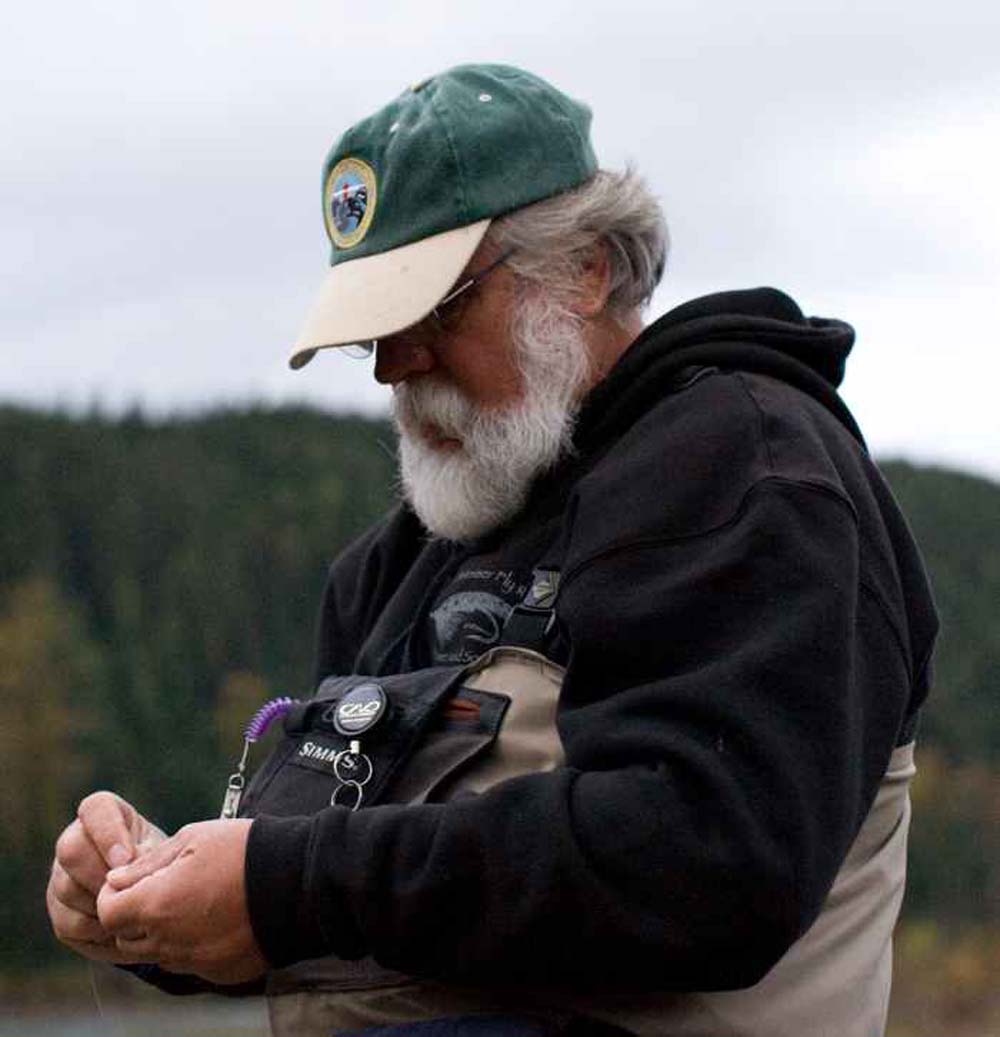
Bob Meiser is one of North America’s greatest fly rod designers/builders. Photo credit Bob Meiser.
Is a switch rod to a conventional fly rod what a spear was to a club?
By Skip Clement
NOTE: Be sure to stay to the end. The video will teach you how simple it is to become a quality fly caster and put the ‘double-haul’ in the closet and never again donate a fly to the forest or mangrove behind you.
No one is going convince a logical person of the angling persuasion that a ‘new,’ top-end fly rod from any one of the majors here in the U. S. is not better to cast, make tighter loops, endure for a lifetime, be surprisingly stronger and lighter than a fly rod made in the land of Oz for one-third of the price.
Some folks suffer from mental illnesses and say, ‘My $18 XYZ fly rod bought on eBay is as good as the ‘newest’ Sage fly rod.’ Only a few remaining Neanderthals say no scientific proof exists of man-manufactured influence on climate. No matter the subject, they run their mouths on social media, parroting the recently found guilty of lying to their audience.
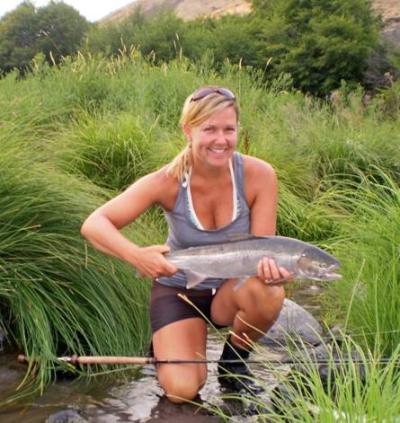
That was another nice catch with an RB Meiser two-handed fly rod. Meiser photo.
Looking back to see ahead
Bob Meiser is the American author of the Switch Rod. The term ‘switch’ got that moniker because a day of casting multiple types of fly lines to ascertain the best-performing combination for that ‘new’ short Spey rod resulted in the comment. ‘So damn much ‘switching,’ and voilà, ‘switch’ stuck.
The first switch rods, made by Meiser in the mid-1970s, were nine feet, nine inches long. They were made for angling friends sick and tired of the physical demands created by double hauling in preparation for each single-handed cast.
The first switch rod ever sold as a company product was by R. B. Meiser Fly Rods. That was in the mid-1980s.
Using two hands to overhand cast with a switch rod was especially appealing to anglers requiring repetitive long-distance deliveries typical of search-casting for large game fish from a boat, beach, or hemmed in riverine topography. And especially a popular rod casting for anadromous Pacific salmon and steelhead turf of the American and Canadian Northwest, and eventually finding a home in the Great Lakes and in pockets in the Canadian Maritimes chasing huge brook trout and the Atlantic salmon. Switch rods are more prevalent in Scandinavia than in any other region and for more species than Atlantic salmon.
After Mieser started showing up at West Coast fly fishing shows and grabbing all the attention, the big-name rod builders quickly capitalized on Meiser’s switch concept and drowned him out by throwing ad money around.
Fast-forward; the major industry players drifted toward switch rod performance characteristics that were more Spey-like, commercially driven yield demanded by users—Northwest U. S. and British Columbia, Canada, big water Spey casting anglers.
Remaining closeted, was that an industry marketing mistake?
Meanwhile, somebody needed to market switch rods professionally or introduce them to other audiences like the cowboy west, Alaska, Mid-America, the East Coast, or Florida. A successful penetration of the Florida market with a 9′, 9″ switch rod, game enough for tarpon and sails, and a perfect ‘boat’ rod would have lit a thousand candles, but that has yet to happen.
Switch rods stayed isolated in the Northwest and British Columbia for decades. Critics still pooh-pooh the switch rod’s Spey performance – not equal to the long rods of European descendants they mimic. And on and on, they go to this day.
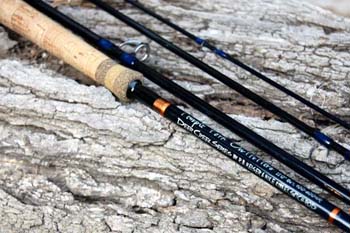
TFO Deer Creek Switch 8110-4. Click on image to visit Salmon River Spey.blog.
TFO Deer Creek Switch – the fly rod they got right the first time
Uniquely, the TFO Deer Creek switch rod series’ mandrels, build-out specs, and performance characteristics have stayed the same since its launch over a decade ago. Why? Well, it is still intact from the start. And two, it was designed by two guys who know more about switch rods than anyone, Bob Meiser and Mike Kinney. As already noted, it was out of Meiser’s shop that the switch rod was born, and Kinney, a veteran two-handed rod designer, became a part of that.
Temple Fork has tweaked with Deer Creek’s “parts” and incidentals over the decade – all of which have drawn equal sentiments of praise and complaint, but the “engine” has never needed service.
What about these legally blonde folks?
Along the way, Scandinavians entered the realm of switch rods, embracing their duality and overriding single-handed casting benefits. They understood that a switch rod was not the “best” Spey casting stick. They left that puerile barroom argument to the Americans.
The Scandinavians accepted switch rodding in its purest form. It was capable of exceptional single-handed casting, fearing no fly-eating backcast, and practical and accurate two-handed casting with a maximum rod length of 11-feet.

Mike Kinney.
Redefining the switch rod and how to cast it most beneficially
The Scandinavians agree with the ‘Yank’ inventor of switch rods with terminal lengths of around 11- feet because limiting the length makes the switch rod the best dual-performance fly rod of all time.
Why an 11-foot limit?
Simple: Try casting overhand any rod longer than 11 feet for an hour, even 6 inches longer than 10 feet six inches, and your arm will reach out to your brain and say, ‘Nuff.’ Some at 12-feet are called switch rods, but they are much more physically demanding.
Another strangeness about the Scandinavians is their two-handed casting technique, which is way better than most on this side of the pond.
Scandinavians use the lower, offhand lever—pulling, not pushing, with the dominant hand. In the States, somebody needed to define better mechanics. Some ‘pros’ have videos claiming that engaging the upper hand as a ‘pusher’ lever helps add distance. I cannot vouch for that as it seems to me to defeat easily and invite more difficulty.
Pull, doing what doesn’t come naturally
It’s an easier, softer way to cast better all day by simply not using your dominant hand (upper hand) as the “pushing” lever. Use the lower hand to pull the rod toward you—better accuracy, longer casts, and no arm, wrist, or shoulder strain. Although punching and quick stopping do employ the wrist, it’s not flopping around. Too, you need to use your finger to hold at the very base of the rod—index and middle digits.
The Switch has always been the perfect boat rod, and Alaskan guides proved it. The Switch in Alaska is the go-to fly rod – hop in.
The TFO switch does not have closely related ‘Middle Class’ relatives, except for Rajeff’s Echo SR.
About the Echo switch option at $330
Echo SR switch rod limits have nothing to do with its castability, build, durability, or performance in any category, but it has everything to do with the selection. Rajeff limits the choices of his 11-foot versions to 6-, 7- and 8-weights. These weights are all saltwater fish weights – big fish. The Echo 3- to 8-weight for fish in the 5- to 25-pound weight class – offshore animals or early-season Chinook salmon.
They can, of course, play well where smaller fish roam – rigged (6-weight).
Offering more
A selection that included lower weights in Rajeff’s Echo SR [switch rods] would create new leadership in mid-priced, high-performance switch rods – a league of their own. Surprisingly, that would make two high-performing switch rods in the Middle-Class cost range.
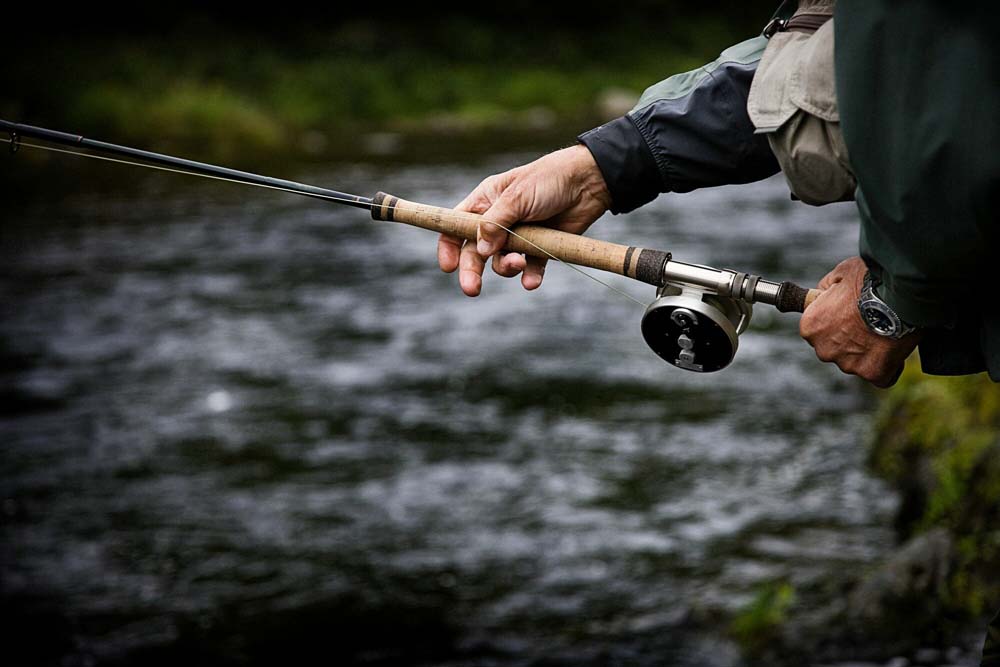
Two-handed casting, which is both spey and switch casting. Envato image.
So, what about the top U.S.-made switch rods?
R. B. Meiser, the Fly Rod company, is the best at producing a complete line of switch rods or anything two-handed. No other U. S. rod builder has as complete a line of switch rods or two-handed fly rods.
Some major name brands have great rods called Switch, but they are sometimes too long to perform well single-handedly. So, they are in a category called mislabeled. A few have terrific switch rods but only in one or two weights.
Most rod makers with switch offerings have one foot in and one foot out – only chocolate and vanilla or devoted to special angling needs. Winston, for example, hit a home run with their entry, Micro Spey. They are beautifully performing 3-, 4- and 5-weight switch rods, “. . . That which we call a rose by any other name would smell as sweet . . .”
There is one not-so-small issue with every fly rod made, and it’s huge with switch rods. What is the best fly line for the rod based on how it’s built to perform, and where and what are you fishing for?Meiser covers that better than any other maker.
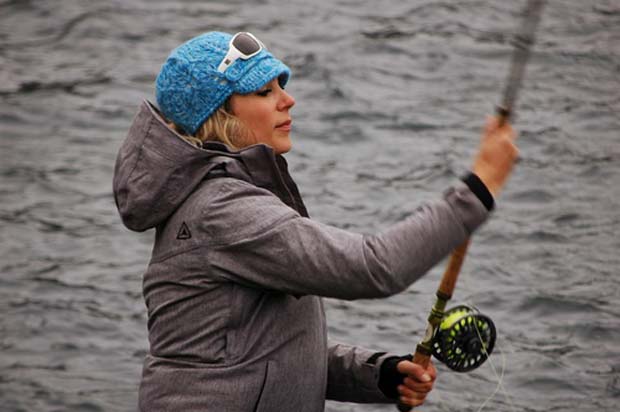
April Vokey spey [switch] casting for Atlantic salmon in Iceland. Photo Vokey.
SIDEBAR: A ‘COVID’ interruption ago
An unsuccessful attempt to marry switch rod design with conventional 9-foot fly rod builds failed [Henry Fly Rod & Reel]. The design idea was to add a short, gripping butt and a lengthened handle to accommodate two-handed casting. Unfortunately, the concept remains unflawed, but undercapitalization and supply chain issues were lethal disruptions to the start-up at the outset of COVID-19 and during it. There was only one initial blunder: timing.
CONTACTS:
Watch this video and learn how to switch casts. It will change your fly fishing life for the better, and do so right away





